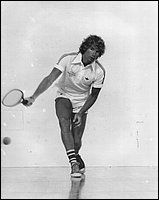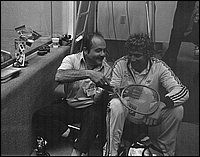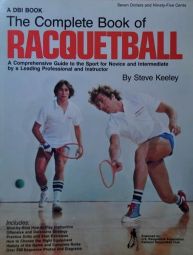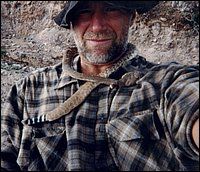by Art Shay, with Steve Keeley
(Swans - August 10, 2009) In the seven years since he gave up full-time hoboing, my friend Steve Keeley, a former racquetball champ and book author like me but now pushing a mere sixty, has lived in an eight-by-ten-foot burrow dug into a toenail of California desert so close to Arizona and Mexico that on bird-silent nights he can hear the drunken curses of obscene coyotes mid-passage scold nursing Mexican mamas to keep their fucking babies quiet when they get off the tit.
The gringo cops, much influenced by TV butterball, the right-leaning alarmist schmuck Lou Dobbs, assumes the whole country is ready to machinegun Mexicans for border-crossing and Obama for the unwritten crime of P.W.B. (Presidenting While Black). These malefactors ready to dispense KKK-style border justice must be avoided at all costs, because no one these days not in the drug trade can afford the current gringo cop rates for averting la cabeza, which can run to $1,000 a nursing mother including passes for her mama and the baby's father. And a hundred for other quieter children, or an easy teenaged sister. The dirty-joke rumor is that a bad batch of mule-borne prescription drugs on this route norte was guilty of giving Rush Limbaugh his up and down yoyo tremors. That or Rush's giant greedy belly bespeaks a bad pregnancy.

|
|
Best backhand in history of racquetball © 1973 Leach Industries |
Keeley has always been a loner with a passion for odd environments. He co-invented paddleball while a veterinarian student at University of Michigan, and got swindled of paddleball's entire $750 treasury by a Chicago racquetball tycoon promising a pro tour. Having been National Paddleball Champion five years in a row, he went on to glory in racquetball singles, sometimes conquering the likes of immortal Marty Hogan and Charlie Brumfield.
Although I won the 1982 Golden Masters North American championship, my greatest racquetball triumph occurred in 1979. I was shooting Steve for Sports Illustrated and we had two hours to kill before my plane. Knowing my predilection for bagels, he gorged on five of them. So I challenged him to a match at a club near the airfield frequented by some of the stewardesses at AA whom he coached when not fucking them.

|
|
Art Shay and Steve Keeley © 1973 Art Shay |
I could tell from his glazed expression that the bagels were weighing him down. I won the first game 15-6. All of a sudden five airline ladies appeared on the balcony and one of them shouted down the line, "Hey everybody -- this chubby little SI photographer just beat Keeley by nine points!" Some thirty spectators instantly filled the balcony to watch their idol, I choked up, and was barely able to eke out the second game, 15-13.
By this time Keeley was so bagel-heavy that he contemptuously got a frying pan from the kitchen and, using it as a racquet, beat me 15-3. He didn't like to lose even one unimportant match, he explained while driving me to the airport.
About this time he began writing the definitive racquetball book -- into the teeth of the 5 instructionals I had done up to then. His incomparable Power Racquetball, which was illustrated by my pictures, became a bestseller. The rest is geography.

|
|
The Complete Book of Racquetball © 1976 Steve Keeley (Photo by Art Shay) |
At twenty-eight, Bo, as he was and is known along the rails of North and South America with a few Asian jaunts, retired from a dull veterinary medicine practice and for a few years lived in a rickety house with his Dobermans, Corn and Flake, sleeping in a pine coffin lined with electric blankets against icy Michigan winters. The 1979 Sports Illustrated story on Keeley, which I illustrated, for some reason dwelled on his being a character unlike most sports champions. It suggested he would emerge from his coffin only to drink the blood of the other ranking pros. Whatever the stakes.
The SI writer doing the story adumbrated him as a kooky national champ who sometimes beat club champions swinging that frying pan (while wearing one red and one blue Converse sneak for the hell of it). This writer, a couch maven, thought there was something Freudian-funny about the way Bo lived. Maybe something deeply parental in his childhood. After all, his father was a space scientist who moved his family 15 times before Steve graduated from high school in Grand Rapids, Michigan. He couldn't imagine that Bo's laid-forward lifestyle, so alien to a New Yorker, seemed logical to him. Bo avers he wasn't trying to prove anything, merely rejecting the way others lived.
"My mother's influence, if any," he told me once, was not to scoff at "my age eight ambition to dig a backyard hole to China. She provisioned me with two Idaho egg rolls -- the second as provender for any Chinese I dug up. She also bought me a worm farm with glass windows, and taught me to respect, study, and wonder at my fellow creatures, including the two, suddenly three, hermaphroditic crawlers I carried in my pocket. My father convinced me I could achieve anything I wanted and to value my dreams as windows to my soul."
Just now, as I've said, Keeley at mid-life is living as a sort of desert animal on that -- under that -- toenail of southern California not far from Arizona and Old Mexico. Most arid denizens, himself and the ones he studies and admires, live underground. "I do have a little house about fifty steps from my hole in the ground plus a rickety trailer in which I store books, process rainwater, and sometimes hitch up to my ancient Ford Contour for field trips," he admits, "but I prefer my burrow lined with house-sale rugs most of the time. I love it in part because it's 40 degrees cooler in the summer than the desert surface and much warmer in the winter. It's quiet, private, and a way to continue my profession. It also serves as an ice-breaker for dates." There is a bouncy waterbed left over from his Hippie days and a part-time girlfriend, a hoboette he met on the rails. This tough and lusty lady is also interested in wild life, including Keeley's.
"Above me, day and night," he has written in his ongoing lifetime notebook (kind of a Thoreau-hits-the-rails saga), "I hear various predators brush by. The owl, vulture and one haughty albino eagle scratch my roof hunting snakes and lizards that chase smaller vermin into tunnels connecting to my own digs. By day, chipmunks seem to take pleasure in targeting me while defecating and spiders in stranding their silk threads down hopefully in my direction. Just fishin'." "I adore my ten human neighbors and my myriad wild ones. We're in this together. My curiosity about them, and I'm sure theirs for me, is endless. I often wonder what they make of me, my solar powered light bulb and solar rooftop inverter running my laptop. And my constricted Yoga regimen. I'm content to spend much of my burrowed time peering through a wire mesh at the feral ones. I installed a wire screen across the lower front of my homey burrow to observe them and watch them react to me -- mostly with bemused tolerance. We know we are mutually harmless. I delight in such regulars as a sidewinder, those bombardier chipmunks, web-casting spiders, packrats, tarantulas, Pepsis wasps, whiptail lizards, stinkbugs, kangaroo mice, a six-foot gopher snake, and a family of 7-inch red-spotted barking geckos, the greediest of which I call Michael Douglas after his role as ruthless Gordon Gekko in the movie Wall Street. I hear Michael leading his clan -- hunting, masticating, and establishing his alpha dominance. All while the entire family yips excitedly like puppies being throttled by a pervert in the dark."

|
|
Rattlesnake for a necktie © 2004 Steve Keeley |
Keeley's burrow is a place from which he regularly writes to some of his 50 lifelong friends -- luckily including me. One of these is the up-down-up financier (and paddleball champ) Vic Niederhoffer. (The New Yorker did an article that mentioned his sending Bo to some exotic country, based on his faith in Keeley's instinct, to appraise an investment opportunity that ended up costing Trader Vic a million or so. Look it up.)
A lucky LA supplement writer got Steve to expatiate on his burrow as serving as a posh (to him) foxhole protecting him from errant practice bombs that occasionally drop on his neighborhood, aimlessly digging involuntary burrows not unlike his. ("The price I pay," he says, "for living under my ten useless acres of white sand located a scant mile from the Chocolate Mountain Gunnery Range.")
(We were then in the Bush [Cheney-Rumsfeld-Rove and oil maven Condoleezza] race to get Iraq's oil and shut down his vasty atomic operation before Saddam could figure out why we were ready to sacrifice 4,000 American kids on his sand. Before like Keeley he moved into a burrow.)
If you were wondering about Keeley's finances, when funds get low he sometimes teaches veterinary medicine and natural healing methods in a community college. Note: When I developed a jumping eye muscle, Keeley (who had helped my failing knees by encouraging me to climb stairs backward) prescribed raising my big Mac atop a ten-inch plinth, to force me to read above eye level. It's worked these past three years! Keeley himself reads and writes mirror-style like da Vinci.
Not long ago, a team of Marines visited a neighbor's trailer to apologize for the impact of a misguided six-foot 1,000-pound cement and sand practice bomb from some airhead's fighter-bomber. It had knocked out his neighbor's picture window and blown her geriatric boyfriend out of his wheelchair and into impotence. The USMC expressed regret, Ma'am -- her neighbors began calling her Bomb Mary -- and paid her handsomely to fill their misguided 14-foot hole and not make trouble about being deprived of her boyfriend's attentions to her smaller arid area. Another neighbor, with whom Bo rode onto the range one night in his hotrod dune buggy, claims to have earned a thousand bucks in illegal salvage on several night missions, retrieving 800-pound-pick-up truckloads of aluminum bomb fins. There's apparently a market for government metal of any kind. On Keeley's trip his wily neighbor evaded a SWAT team chopper "that chased us with a stuttering machine gun and aerial spotlight as we serpentined an escape through desert washes. I was half-amused and half-terrified of dying so preposterously." Keeley adds, "My neighbor recently abandoned his nighttime target area forays for the equally profitable practice of guiding feckless Hollywood types trailing feckless writers and their paparazzis with 600-mm telephotos and 20-frame-a-second Canon digitals, shooting home-on-the-range photos for the tabloids. Government propaganda and the terrified alarmist Lou Dobbs aside, most borders out here are laughably porous."
Sometimes Keeley unavoidably clashes with the rat race of life outside his burrow. This makes him redouble his efforts to commune with his mammal, bird, bug, and herpetological co-inhabitants. It reminds him that we may not have much time left. Foolish to worry, he guesses. "They've been around eons longer than our breed. And will surely survive us and our pretensions of social order. And possible mass annihilation. I study how they've done it, in vain. In my own way, thinking survival, I often emulate the upside-down bug engineers in our communal tunnels. I like to read books turned upside-down and do mirror-writing to see the world from their perspective. And incidentally to better track incoming missiles from right to left like the Israelis and Arabs both do." He's also felt like a sluggard learning from the ants how to carry heavy loads, sometimes walking his burdens backward up the stairs to condition his sturdy calves.
One recent morning, the tough nature-girl lady friend of Bo's showed up for a day's visit and some tough-muscled sugar before riding the rails to Mexico. Just before they moved below "so she could see through my observation screen, we perceived two praying mantises warily mating on the rooftop solar panel. I told my sister voyeur that the female usually gnawed off the male's head after mating."
"I love it!" she cried. Possibly thanks to the heat of the solar panel, the lucky male vamoosed. "'The son of a bitch got away!' my guest said disappointedly. 'How come, Bo?'" Says he, "I theorized for her that living in the desert changed us all. Unless the Heisenberg principle was at work: The simple act of observation changing the behavior of the observed. We descended my packed-dirt stairs for further study."
"If I stay over," she asked Bo as they eyed his waterbed, and carefully trod the cool earthen floor to avoid a baby sidewinder, "do you think I'll see Michael Douglas?"
If you find Art's work valuable, please consider helping us financially.